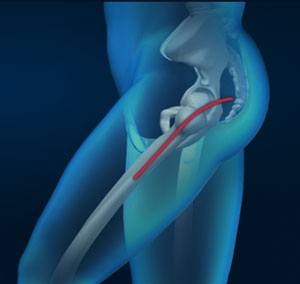
What is Posterior Hip Replacement?
Posterior hip replacement is a minimally invasive surgical procedure in which the worn out or damaged surfaces of the hip joint are removed and replaced with artificial joint components made of metal, ceramic, or plastic. It is also referred to as muscle sparing surgery because key muscles and tendons are left intact while accessing the hip joint, enabling a quicker return to normal activity.
The posterior approach is traditionally the most common approach used to perform a total hip replacement. In a posterior hip replacement, the surgeon makes the hip incision at the side of the hip close to the buttocks. The incision is placed so the abductor muscles, the major walking muscles, are not cut.
Hip Anatomy
The hip joint is one of the body's largest weight-bearing joints and is the point where the thighbone (femur) and pelvis (acetabulum) join. It is a ball-and-socket joint in which the head of the femur forms the ball and the pelvic acetabulum forms the socket. The joint surface is covered by a smooth articular cartilage that cushions and enables smooth movement of the joint.
Indications
Hip replacement is indicated in patients with arthritis of the hip joint. Arthritis is a condition in which the articular cartilage that covers the joint surface is damaged or worn out causing pain and inflammation. Some of the causes of arthritis include:
- Advancing age
- Congenital or developmental hip diseases
- Obesity
- Previous history of hip injury or fracture
- Increased stress on hip because of overuse
Symptoms
Patients with arthritis may have a thinner articular cartilage lining, a narrowed joint space, presence of bone spurs, or excessive bone growth around the edges of the hip joint. Because of all these factors arthritis patients can experience pain, stiffness, and restricted movement.
Diagnosis
Your doctor will evaluate arthritis based on the characteristic symptoms and diagnostic tests. Your orthopedic surgeon will perform a physical examination, order X-rays and other scans, and also some blood tests to rule out any conditions that may cause similar symptoms.
Procedure of Posterior Hip Replacement
During the procedure, you will lie on your side in a lateral position. A surgical cut is made along the side of the hip to expose the hip joint and the femur is dislocated from the acetabulum. The surface of the socket is cleaned and the damaged or arthritic bone removed using a reamer. The acetabular component is inserted into the socket using screws, or occasionally, bone cement. A liner made of plastic, ceramic, or metal is placed inside the acetabular component.
The femur or thighbone is then prepared by removing the arthritic bone using special instruments to exactly fit the new metal femoral component. The femoral component is then inserted into the femur either by a press fit or using bone cement. Then the femoral head component made of metal or ceramic is placed on the femoral stem. All the new parts are secured in place using special cement. The muscles and tendons around the new joint are repaired and the incision is closed.
Post-operative Care and Recovery
In general, postoperative care instructions and recovery after posterior hip replacement will involve the following:
- You will be transferred to the recovery area where your nurse will closely observe you as you recover.
- You may need to stay in the hospital for a day before discharge to home.
- You will be able to walk on the same day after your surgery with assistance.
- You are advised to follow certain instructions to protect your hip. These include not bending or flexing the hip past 90 degrees, no crossing of legs, and no rotating the operated leg inward.
- Take medications as prescribed to relieve pain and prevent infection.
- Keep the surgical site clean and dry. Instructions on surgical site care and bathing will be provided.
- An individualized physical therapy protocol will be designed to help strengthen hip muscles and optimize hip function.
- Eating a healthy diet rich in vitamin D is strongly advised to promote healing and a faster recovery and refrain from smoking as it can hinder the healing process.
- Refrain from strenuous activities for the first few months and lifting heavy weights for at least 6 months. Gradual increase in activities over a period of time is recommended.
- Contact your doctor if you observe increasing swelling or redness in the operated area.
- A periodic follow-up appointment will be scheduled to monitor your progress.
Advantages
The advantages of the posterior approach include:
- High success rate
- Minimally invasive
- No muscle damage
- More precise placement of implants
- Allows excellent visibility of the joint
Risks and Complications
Posterior hip replacement is a relatively safe procedure; however, as with any surgery, some risks and complications may occur, such as the following:
- Dislocation
- Infection at the incision site or in the joint space
- Fracture
- Nerve damage
- Hemarthrosis: excess bleeding into the joint after the surgery.
- Deep vein thrombosis (blood clot)
- Leg length inequality






